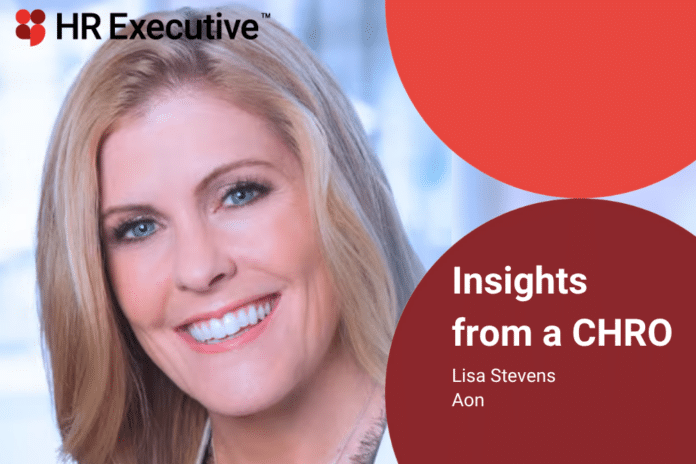As any people professional today knows, change is coming fast and non-stop for HR. The key to helping the organization stay one step ahead? Workforce resilience.
That’s according to Lisa Stevens, chief administrative officer at global professional services firm Aon. Stevens—who oversees the people, marketing and communications, and public affairs units for the 60,000-person organization—says ongoing economic shifts, climate events and AI advances are making the world move at a much faster pace, driving up risks for companies. Aon’s approach to reducing risk is to confront these change agents—which it categorizes into four megatrends: trade, technology, weather and workforce—through workforce resilience.
“The organizations that thrive in this environment understand the interconnectedness of these Megatrends and, critically, invest in resilient, adaptable workforces that are prepared for today’s and tomorrow’s challenges,” Stevens says.
HR should see workforce resilience as a counterpart to risk management, given the deep connection between financial and people risks, she says. “Navigating this complexity requires a unified, strategic approach,” she says.
Stevens, who spent nearly three decades at Wells Fargo before joining Aon in 2018, spoke with HR Executive about how the firm is strategizing for workforce resilience, especially in the face of challenges like employee burnout and AI integration.
HR Executive: What are the most effective ways HR can help their organizations lean into workforce resilience, and how can they measure success?
Stevens: A healthy workforce is often a resilient one. True resilience requires a holistic approach to physical, mental, financial, social and emotional wellbeing supported by systems that enable people to recharge and perform at their best.
My advice to HR leaders is to focus on the benefits that truly move the needle for your people and be willing to innovate new solutions that meet the evolving needs of your workforce.
At Aon, we’re seeing this in action through our recently launched GLP-1 weight management program for U.S. employees, which provides affordable access to weight-loss medication along with virtual support and adherence tools. After conducting extensive research on GLP-1 treatments, we’re proving it’s possible to offer access to GLP-1s affordably and with dignity—and that doing so can benefit our colleagues, their families and the bottom line.
HR Executive: Given rising burnout among HR professionals themselves, what can the function do to ensure its own teams are resilient in the face of leading constant change?
Stevens: Balance isn’t a luxury; it’s a leadership responsibility. We have to embed wellbeing into how the people organization operates or risk burning out the very teams tasked with supporting others.
At Aon, we anchor our approach in five wellbeing principles: Prioritize, Set Boundaries, Recover, Seek Support and Share Your Stories. These principles guide how we lead and support our teams through constant change.
One thing I encourage my own team at Aon to do is to have wellbeing conversations: brief check-ins with team members about how they’re doing and their goals this year related to their physical, mental, emotional and social, and financial wellbeing. These short conversations are great sources of encouragement—and much-needed accountability to invest in our health.
I also believe in the power of short, quality breaks—even for five minutes. Small investments in balance and boundaries help us stay more engaged and productive over time.
HR Executive: Among the biggest disruptors is AI. What do you see as the biggest people obstacle to effective AI integration that HR needs to confront now?
Stevens: Our Human Capital team at Aon conducted research around this topic, and the results were surprising: Only one in three workers globally feels motivated to build AI skills. That’s simply not enough—and HR is in the right position to change that.
HR needs to help people see AI as an opportunity to improve their work and lives. But this isn’t just about adopting new technology; it’s about building trust. People need to see the value of AI for their career development and feel supported through the change.
Leaders also set the tone and make their teams feel safe using AI. At Aon, we host an “AI minute,” where leaders take time each week to share how they’re using AI with their teams. It helps demystify AI, humanize it and make it real.
HR Executive: How will transformations like AI integration challenge HR to lean into skills that were not previously part of the HR professional profile?
Stevens: AI empowers our HR team to dedicate more time and energy to what truly matters: our people. By automating routine tasks, AI enables us to focus on developing essential skills that help leaders lead effectively, foster inclusive teams and unlock the full potential of our workforce.
But AI integration isn’t just an HR initiative; it’s a business transformation that must be leader-led. While HR plays a critical role in guiding adoption and upskilling, it’s our leaders across the organization who are responsible for modeling how AI can be used to enhance decision-making, collaboration and wellbeing.
To support this, we embrace a culture of continuous learning. HR must stay ahead by experimenting, learning and sharing successful strategies across the firm. For example, during the launch of AonGPT, my team shared practical tips with leaders on how to use AI to foster compassion and wellbeing within their teams. It’s a clear example of how HR can enable and amplify leader-led innovation.
HR Executive: In your decades in the HR profession, how has your approach to HR leadership shifted?
Stevens: My journey to the chief people officer role at Aon has been unique, as I didn’t start my career in HR. I began at Aon as an EVP, supporting our Aon United transformation with a focus on strategy and adoption. Later, I held client-facing roles, including serving as CEO of Talent Solutions. This diverse background has significantly influenced my leadership style and vision for the future. I approach HR primarily as a strategist and business driver, ensuring our work aligns with the organization’s broader goals and helps our teams deliver impactful results where it matters most.



